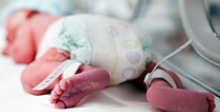Internal mini form
Contact Us Today
Placenta complications can result in excessive bleeding, prevent enough blood, oxygen, and nutrients to reach to the fetus, and may stall fetal development. Learn the most common signs of placental complication and how they are diagnosed.
What placenta complications can increase the risk of Cerebral Palsy?
Placenta complications can result in excessive bleeding, cause a lack of blood, oxygen, and nutrients reach to the fetus, and may stall fetal development. Premature birth and complicated deliveries can result from placental complications. All these factors increase the likelihood of a child developing Cerebral Palsy.
The most common signs of placental problems are vaginal bleeding and pain. Most cases are diagnosed by ultrasound and can be detected in the second and third trimesters.
The placenta is a pancake-shaped organ that develops during pregnancy to transfer blood, nutrients, and waste to and from the fetus. The placenta attaches to top of the uterine wall in the womb while the umbilical cord connects the placenta to the fetus.
Placenta Abruption (Placenta Abruptio)
Placenta abruption, which occurs after 20 weeks of pregnancy in about 1% of pregnancies, takes place when the placenta detaches from the uterine wall prior to delivery. Severe cases of complete abruption necessitate an immediate delivery, most likely through cesarean.
Milder cases of partial abruption are treated based on severity and gestational period. Whenever possible, pregnancy will be carried to term, but monitored as high-risk. Women with partial abruptions may be placed on bed rest or be required to stay in a hospital to ensure the abruption is monitored.
Doctors will attempt to determine whether the abruption will result in a premature delivery. When this is suspected, corticosteroids may be administered to speed lung development in the fetus.
Placenta Previa
Placenta Previa occurs in roughly one of every 200 pregnant women when the placenta blocks the cervix. This condition can be very serious for both mother and child, potentially blocking blood flow to the fetus and restricting intrauterine growth. For the mother, risks include excessive hemorrhaging and placenta accreta (attachment to uterine muscle), complications that may necessitate cesarean delivery. In some cases, placenta previa diagnosed in the second trimester will resolve by the time of delivery.The condition, however, must be monitored by a doctor.
Placenta Previa is divided into three types based on the amount of cervical blockage; complete, partial, and marginal. A diagnosis can be made with an ultrasound. Warning signs for pregnant women include:
- Painless bleeding in the third trimester
- Premature contractions
- Severe back pain
- Enlarged uterus related to gestation age
Were you or your child at risk – before, during or after your child’s birth?
Cerebral Palsy risk factors are events, substances or circumstances that increase the chances of a child developing Cerebral Palsy. They can be avoidable, or unavoidable. A risk factor does not ensure a child will develop Cerebral Palsy; it means chances are higher than if that risk factor was not present. Likewise, the absence of risk factors does not ensure that a child will not develop Cerebral Palsy. Have you been exposed to the following risk factors?
- Cerebral Palsy Risk Factors
Types of risk factors:
- Asphyxia and oxygen deprivation
- Blood type incompatibility or jaundice
- Complications of birth
- Infection
- Intrauterine growth restrictions
- Multiple births and infertility drugs
- Parental health and habits
- Placenta complications
- Premature birth
- Traumatic brain damage
Risk factors vs. risk factor causal pathways
A risk factor does not ensure a child will develop Cerebral Palsy; it means chances are higher than if that risk factor was not present. Likewise, the absence of risk factors does not ensure that a child will not develop Cerebral Palsy.
- Risk Factors and Risk Factor Causal Pathways
The Cerebral Palsy Risk Factor Checklist
Any exposure to risk factors prior to conception and during pregnancy should be immediately discussed with a doctor in order to treat and minimize risk. The Cerebral Palsy Risk Factor Checklist helps parents determine if they may have been exposed to risk factors for Cerebral Palsy.
- The Cerebral Palsy Risk Factor Checklist









